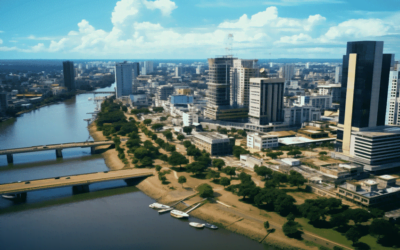Hey there, fellow drone enthusiasts! If you’ve found your way here, chances are you’re curious about the drone scene in Malaysia, and you’re seeking answers about Malaysia’s drone laws. Well, you’re in the right place.
As someone who’s been deeply intrigued by the world of unmanned aerial systems, I completely understand the quest for clarity when it comes to the regulations that govern our soaring devices.
My journey into understanding Malaysia’s drone laws started with a burning desire to unlock the full potential of my drone.
I wanted to explore the skies, capture breathtaking aerial views, and share the wonders of this technology with fellow enthusiasts.
That’s when I realized that a solid understanding of the legal aspects was paramount to ensuring both safe and enjoyable flights.
After hours of research, I can confidently say that I’ve got the answers you’re looking for. I’ve delved into the intricacies of Malaysia’s drone laws, ensuring that I can provide you with the most up-to-date and comprehensive information.
So, if you’re eager to navigate the skies of Malaysia with confidence and compliance, you’re in the right place. Keep reading, and I’ll walk you through all the key aspects of Malaysia’s drone laws to help you spread your wings while staying on the right side of the law. Let’s get started!
- Overview of Drone Laws in Malaysia
- Malaysia Registration and Licensing
- Categories of Drone Operators in Malaysia
- Malaysia Drone Flight Restrictions
- Malaysia Safety and Privacy
- Special Permissions and Permits in Malaysia
- Malaysia Drone Remote ID and Insurance
- Malaysia Recent Updates and Changes
- Final Thoughts on Malaysia Drone Laws
- Frequently Asked Questions About Malaysia Drone Laws
Overview of Drone Laws in Malaysia

So, before we dive headfirst into the nitty-gritty of Malaysia’s drone regulations, let’s set the stage by providing a bit of historical context.
Drone regulations, like those of many other countries, began to take shape as the popularity of unmanned aerial systems soared.
In Malaysia, the journey towards regulating drones commenced as these flying marvels captured the imaginations of hobbyists, photographers, and businesses alike.
The regulatory authority that you need to acquaint yourself with when it comes to drone operations in Malaysia is the Civil Aviation Authority of Malaysia, or CAAM for short.
They’re the ones steering the ship when it comes to making sure drone flights across the country are safe, compliant, and enjoyable. As technology evolves and the drone landscape keeps expanding, it’s crucial to know the rudder that guides us. CAAM is our captain.
Now, why should we all care about adhering to these drone laws, whether we’re residents or visitors? Well, that’s a question that deserves a straight answer.
These laws aren’t here to rain on our parade; they’re here to ensure that our drone flights are fun and, more importantly, safe. For residents, it’s about being responsible and avoiding potential fines or legal troubles.
For visitors, understanding these laws is vital to avoid any unpleasant surprises while exploring the skies of Malaysia.
So, whether you’re a local drone enthusiast or someone visiting this beautiful country, you’ve got a role to play in making sure the drone scene stays soaring high and safe.
Also Read: Malawi Drone Laws
Malaysia Registration and Licensing

Let’s take a closer look at the nuts and bolts of registration and licensing when it comes to drones in Malaysia.
Drone Registration
In the world of drone operations, registration is a term that pops up often, and it’s a mandatory step for all drone owners in Malaysia.
Whether you’re a resident or a visitor, the law requires you to register your drone with the Civil Aviation Authority of Malaysia (CAAM).
This is a vital step, as it helps authorities keep track of the ever-growing drone community in the country. Registration typically involves providing essential information about your drone, including its make, model, and serial number, along with your own contact details.
Registering Your Drone
Now that we’ve established the ‘why,’ let’s delve into the ‘how’ of drone registration in Malaysia. The process isn’t as complex as it might seem. You’ll need to visit CAAM’s website, where they usually have a dedicated section for drone registration.
Follow the on-screen instructions, fill in the necessary details, and, of course, be ready to provide proof of ownership, which can be in the form of purchase receipts or invoices. It’s essential to ensure that your drone is registered before you take it to the skies.
Why a Drone Pilot License Matters
Drone pilot licenses, in essence, are your wings to the sky. They’re the official endorsements that acknowledge your ability to operate a drone safely and responsibly. Whether you’re flying for personal enjoyment or engaging in commercial drone activities, obtaining a drone pilot license is a must.
This license is proof that you’ve completed the necessary training, understand the rules of the sky, and can handle your drone in various situations, ensuring safety for everyone below.
Demystifying the Difference
A common point of confusion in the drone community is understanding the difference between registration and licensing. Simply put, drone registration focuses on your aircraft—the drone itself.
It’s about ensuring that authorities can trace your drone back to you if needed. On the other hand, drone licensing is about you, the pilot. It confirms that you have the skills and knowledge to operate a drone safely.
While registration is about your drone, licensing is about you as a responsible operator. So, in essence, you’ll need both to fly legally in Malaysia. Remember, both are essential for a safe and enjoyable journey through the Malaysian skies.
Also Read: Madagascar Drone Law
Categories of Drone Operators in Malaysia

Understanding who can fly drones in Malaysia and the specific regulations for different categories is vital to navigating the skies legally and responsibly.
Tourists/Visitors vs. Government Drone Operators
First, let’s make a clear distinction between tourists and government drone operators. In Malaysia, these two groups of operators operate under distinct sets of rules.
Tourists and visitors are individuals who are in Malaysia temporarily, usually for leisure or travel purposes, while government drone operators encompass various agencies and organizations authorized to use drones for official purposes.
Navigating the Regulatory Landscape
Now that we’ve identified the categories, let’s dig into the specific regulations for each. For tourists and visitors, there are several key points to remember. Registration is required, to ensure that authorities can trace your drone back to you if needed.
While drone Remote ID is not mandatory for tourists, it’s a sensible practice to enhance safety and accountability. Drone insurance is also not mandatory but is recommended, especially for those engaging in recreational or professional drone activities.
On the other hand, government drone operators have a different set of rules. Registration is required for their drone operations, as it is for tourists.
However, government operators are exempt from the obligation to have a drone Remote ID. Moreover, drone insurance is not mandatory for government drone operations, reflecting the distinction between commercial and government activities.
The Importance of Rule Adherence for Visitors
For foreign visitors exploring the Malaysian skies with their drones, adhering to these rules isn’t just a legal requirement; it’s a way to ensure a positive experience for everyone involved.
Malaysia offers a fantastic backdrop for aerial photography and exploration, and respecting these rules is essential to keeping the skies safe.
Whether you’re capturing breathtaking landscapes or filming your adventures, following the regulations is a must. It ensures your own safety and the safety of those on the ground, creating an enjoyable environment for all drone enthusiasts in Malaysia.
So, if you’re a tourist ready to take off, remember to follow the guidelines; it’s the responsible way to soar in Malaysian skies.
Also Read: Luxembourg Drone Law
Malaysia Drone Flight Restrictions

Navigating the skies with a drone is exhilarating, but it comes with its fair share of responsibilities. Understanding the restrictions and guidelines for drone flights in Malaysia is essential for safe and enjoyable aerial adventures.
No-Fly Zones
First and foremost, let’s talk about the areas where your drone should remain firmly grounded. Malaysia, like any other country, designates specific no-fly zones to protect the safety and security of its citizens.
These zones typically include airports, military bases, government buildings, and other sensitive locations. It’s crucial for drone operators to be aware of these areas and steer clear of them to avoid potential legal issues and, more importantly, to ensure the safety of all.
Altitude and Distance Restrictions Zone
Understanding altitude and distance restrictions is another vital aspect of flying a drone in Malaysia. In general, drones are required to fly below a certain altitude, typically set at around 120 meters or 400 feet.
This limitation is in place to prevent drones from interfering with manned aircraft. Additionally, maintaining a specific distance from people, property, and vehicles is essential to ensuring safety and privacy. These regulations exist to safeguard both the drone operator and the public on the ground.
Visual Line of Sight (VLOS)
One key rule in drone operations is the need to maintain a visual line of sight (VLOS) with your drone at all times.
This means that you should always be able to see your drone with your own eyes during the flight. While modern technology, like First-Person View (FPV) goggles, can provide an immersive experience, flying beyond the limits of VLOS can be risky.
Adhering to VLOS rules is essential for safe and responsible drone operations, ensuring you can react to unexpected obstacles and maintain awareness of your surroundings.
Adhering to these flight restrictions isn’t just about following the rules; it’s about ensuring the safety of everyone involved, including yourself and those on the ground.
Respect for these regulations paves the way for an enjoyable and incident-free experience as you explore the skies of Malaysia.
So, as you prepare to take flight, remember to keep no-fly zones, altitude and distance restrictions, and VLOS at the forefront of your mind. It’s the key to a soaring adventure while staying within legal bounds.
Also Read: Lithuania Drone Law
Malaysia Safety and Privacy

Flying drones is more than just a hobby; it’s a shared responsibility to ensure the safety and privacy of everyone involved. Let’s delve into why these aspects are critical.
Safety First
Safety should always be the top priority when it comes to drone operations. While drones offer a unique and thrilling perspective, they can pose risks if not operated responsibly.
Adhering to safety guidelines and regulations ensures that flights are incident-free and enjoyable.
This means understanding and following no-fly zones, altitude limits, and distance restrictions. It means knowing your drone inside and out and conducting regular maintenance.
Safety isn’t just a rule; it’s a mindset. So, whether you’re a seasoned drone pilot or a novice, embracing safety practices is a fundamental part of the journey.
Privacy Matters
With drones capable of capturing high-resolution images and videos, privacy concerns naturally come into play. It’s crucial for drone operators to respect the privacy of individuals and property.
Avoid taking pictures or videos of private property without consent, and refrain from activities that infringe upon someone’s personal space. Understanding and respecting the boundaries of privacy is a responsibility that comes with the privilege of exploring the skies.
It’s about striking a balance between our passion for aerial photography and the rights of others to their privacy.
Responsibility in the Skies
As a drone operator, the safety and privacy of your flights lie in your hands. It’s your responsibility to operate your drone in a manner that doesn’t jeopardize anyone’s well-being.
This includes being aware of your surroundings, avoiding crowded areas and public events, and ensuring your drone is in excellent working condition.
In the end, being a responsible drone operator means being a good steward of the skies. It means leaving a positive impression on those who may not be as familiar with drones.
So, as you embark on your flying adventures, remember that the responsibility for safety and privacy is yours, and it’s a responsibility worth upholding.
Also Read: Liechtenstein Drone Law
Special Permissions and Permits in Malaysia

In the world of drone operations, there are times when you might need a little something extra to take flight. Special permits and permissions are your key to unlocking unique opportunities and ensuring legal compliance.
When Special Permits Come into Play
Special permits come into play in certain situations that deviate from standard recreational drone flights. One of the most common scenarios is when you’re looking to engage in commercial drone operations.
If you plan to use your drone for activities like aerial photography, videography, or any form of profit-making venture, you typically need a special permit.
Additionally, if your flight takes you into controlled airspace, for instance, near airports or during special events, you might need permission to ensure safety and coordination with other airspace users.
The Process of Permission: Navigating the Path
Obtaining special permissions typically involves a process that includes several key steps. You’ll need to prepare a formal application outlining the details of your planned flight, including the location, purpose, and duration.
This application is submitted to the Civil Aviation Authority of Malaysia (CAAM), the regulatory body responsible for managing drone operations in the country.
CAAM will then review your request and assess its feasibility and safety aspects. Once your application is approved, you’ll receive the necessary documentation that allows you to proceed with your special drone operation.
Examples That Call for Special Permits
So, when might you find yourself in need of one of these special permits? Let’s consider a few scenarios. Imagine you’re a professional photographer hired to capture aerial shots of a new development project in a city.
In this case, your commercial drone operation would require a special permit. Or, suppose you’re planning to film a documentary that takes you into areas with controlled airspace.
Again, you’d need permission to conduct your aerial work safely and in compliance with the law. Special permits are about making sure your unique drone operations are both legal and secure. They provide the flexibility to explore new horizons while ensuring the safety of the skies.
Also Read: Libya Drone Law
Malaysia Drone Remote ID and Insurance

Drone technology continues to evolve, and along with it, new concepts like Drone Remote ID and insurance have emerged. Let’s delve into these aspects and understand their significance.
Drone Remote ID
Drone Remote ID is a concept that’s gained increasing importance in the world of drones. It’s all about ensuring accountability and safety in the skies.
Essentially, Remote ID is a system that allows authorities to identify and track drones while they’re in flight. Think of it as a digital license plate for your drone. This system enables the monitoring of drone flights and aids in ensuring that they are operated within legal boundaries.
It’s an important step in enhancing the safety and security of the airspace, both for drone operators and the general public.
The Insurance Question
Now, let’s address the question that often arises: Is insurance mandatory for drone operations in Malaysia? The short answer is no; insurance isn’t legally required for all drone operators. However, and this is a significant ‘however,’ it’s highly recommended.
Drone insurance is a safety net that can save you from potentially substantial financial losses in the event of accidents, damage, or liabilities. Whether you’re flying recreationally or for commercial purposes, having insurance coverage is a smart move.
It ensures that you’re financially protected and can continue to pursue your passion for drones without undue worry.
Recommendations for Drone Insurance
When it comes to drone insurance, it’s not a one-size-fits-all scenario. Recommendations can vary based on your specific circumstances.
For recreational drone operators, it’s advisable to explore personal liability insurance or check whether your existing insurance policies cover drone-related incidents.
For those engaged in commercial drone operations, it’s best to seek out specialized drone insurance policies. These policies are tailored to address the unique risks and requirements of commercial drone use.
When selecting an insurance plan, consider factors like coverage limits, deductibles, and the extent of coverage for different scenarios.
In essence, drone insurance is a safety precaution that can offer peace of mind, and it’s a prudent investment for responsible drone enthusiasts.
So, as you prepare for your drone flights, consider the importance of Drone Remote ID for accountability in the skies and the wisdom of having insurance to protect your interests. It’s all about ensuring safe, secure, and responsible drone operations.
Also Read: Liberia Drone Law
Malaysia Recent Updates and Changes

Staying on top of evolving rules and regulations is a crucial aspect of responsible drone operations. Let’s explore why being up-to-date with Malaysia’s drone laws matters.
The Need to Stay Informed
In the dynamic world of drone regulations, changes and updates are not uncommon. Authorities are continually fine-tuning the rules to adapt to the ever-growing drone community and the emerging technologies in the field.
While I don’t have specific recent updates to share (as of my last knowledge update in September 2021), it’s essential for drone enthusiasts to keep an eye out for any changes that may have occurred since then.
The Importance of Keeping Current
The reasons for staying informed are crystal clear. By keeping yourself updated with the latest regulations, you ensure that you’re flying your drone within the boundaries of the law.
This not only avoids potential legal issues but also contributes to overall safety in the skies. Moreover, staying current allows you to take advantage of new opportunities and technologies as they become available.
Drones are a rapidly advancing field, and being aware of the latest trends and regulations empowers you to make informed decisions about your equipment, flights, and aerial projects.
In summary, while I may not have access to the very latest updates, I strongly encourage all drone operators, whether residents or visitors, to stay informed about the evolving drone laws in Malaysia.
It’s a responsible practice that ensures you’re always flying within legal boundaries and contributing to a safe and enjoyable drone community.
Final Thoughts on Malaysia Drone Laws

As we wrap up our journey through Malaysia’s drone laws, let’s reflect on what we’ve uncovered and look ahead to what’s next.
The world of drone operations is a thrilling one, offering a unique perspective and boundless opportunities for enthusiasts and professionals alike.
Malaysia’s drone laws, as we’ve explored, are designed to ensure that these opportunities are embraced responsibly and safely.
By understanding the regulations, we pave the way for enjoyable and incident-free flights, whether we’re capturing mesmerizing landscapes, delivering packages, or simply experiencing the joy of soaring through the skies.
At the heart of it all is the responsibility we bear as drone operators. It’s not just a legal obligation; it’s a commitment to ensuring that our passion for drones aligns with safety and respect for the privacy of others.
Every flight we undertake carries with it the potential to leave a positive impression, not only on fellow drone enthusiasts but on those who may not be as familiar with the world of unmanned aerial systems.
So, I encourage you, whether you’re a seasoned pilot or a newcomer, to be responsible in your drone operations and to follow the regulations that guide our flights.
In the fast-evolving world of drones, staying informed is the key to staying safe and making the most of the opportunities available. I recommend keeping an eye on official sources like the Civil Aviation Authority of Malaysia (CAAM) for the latest updates and changes in regulations.
Additionally, online forums and communities dedicated to drones are valuable resources for connecting with fellow enthusiasts, sharing experiences, and staying updated on the latest trends and developments.
So, as you prepare to take flight or continue your drone journey, remember that the skies are vast and filled with potential. By being responsible and staying informed, you contribute to a vibrant and secure drone community in Malaysia. Fly high and fly safe!
Frequently Asked Questions About Malaysia Drone Laws
Let’s tackle some of the most frequently asked questions regarding Malaysia’s drone laws and regulations.
Q1: Do I need to register my drone in Malaysia?
A1: Yes, drone registration is mandatory in Malaysia, whether you’re a resident or a visitor. Registration is a way for authorities to keep track of drone ownership and ensure accountability in the skies.
Q2: Is drone insurance required for all operators in Malaysia?
A2: Drone insurance is not mandatory for all operators in Malaysia, but it’s highly recommended. Having insurance coverage is a smart move, offering financial protection in case of accidents, damages, or liabilities, which can save you from substantial losses.
Q3: Are there no-fly zones in Malaysia for drones?
A3: Yes, there are designated no-fly zones in Malaysia, which typically include airports, military bases, and other sensitive areas. Drone operators should steer clear of these zones to ensure safety and compliance with the law.
Q4: How do I obtain a drone pilot license in Malaysia?
A4: To obtain a drone pilot license in Malaysia, you’ll need to undergo the necessary training and certification process. The license confirms that you have the skills and knowledge to operate a drone safely and responsibly.
Q5: Can tourists or visitors fly drones in Malaysia?
A5: Yes, foreign tourists and visitors can fly drones in Malaysia. However, they are required to register their drones and follow the same regulations as residents. It’s essential to be aware of the rules and adhere to them to ensure a safe and enjoyable experience while flying in Malaysia













